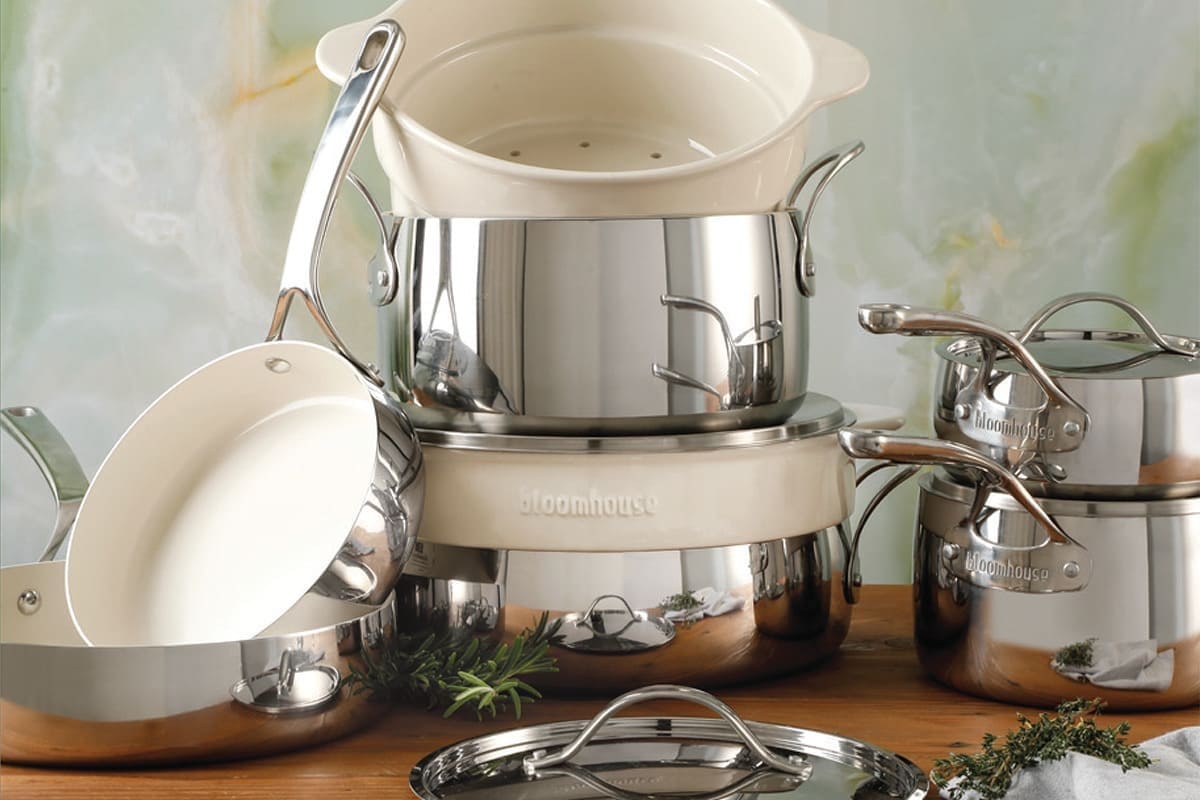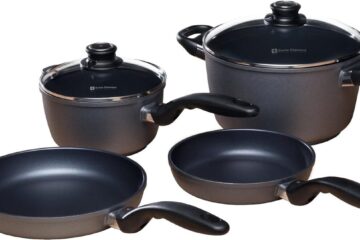Stainless steel cookware is a popular choice for many home cooks due to its durability and sleek appearance. However, many people wonder if stainless steel cookware is non-stick. The short answer is no, stainless steel cookware is not non-stick.
Unlike non-stick cookware, stainless steel cookware does not have a non-stick coating. This means that food can stick to the surface of the cookware, especially if it is not properly heated or if the pan is not seasoned correctly. However, with proper technique and a little bit of oil or butter, stainless steel cookware can be used to cook a wide variety of foods. In fact, many professional chefs prefer stainless steel cookware because it allows for better browning and searing of meats and vegetables.
What is Stainless Steel Cookware?
Stainless steel cookware is a popular choice in the kitchen due to its durability, sleek design, and excellent heat conduction properties. It is made by combining iron, carbon, and other elements such as chromium and nickel, which gives it its unique properties.
Stainless steel is a non-reactive metal, which means that it does not react with acidic or alkaline foods. This makes it an excellent choice for cooking a wide range of dishes, including those with tomatoes, wine, or vinegar.
One of the most significant advantages of stainless steel cookware is its versatility. It can be used for a variety of cooking methods, including frying, sautéing, boiling, and even baking. It is also oven-safe, making it a great choice for dishes that require a combination of stovetop and oven cooking.
Stainless steel cookware is also relatively easy to clean, and it does not require any special maintenance. It can be washed with soap and water or placed in the dishwasher for easy cleaning.
When shopping for stainless steel cookware, it is essential to look for high-quality options. Cheaper stainless steel cookware may have a lower percentage of chromium and nickel, which can result in rusting or discoloration over time. It is also important to consider the thickness of the cookware, as thicker options will provide better heat distribution and retention.
Non-Stick vs. Stainless Steel Cookware
When it comes to choosing cookware, there are two main types to consider: non-stick and stainless steel. Each type has its own unique benefits and drawbacks, and it’s important to understand the differences between the two before making a decision.
Non-Stick Cookware
Non-stick cookware is typically made of aluminum or stainless steel and is coated with a non-stick finish that prevents food from sticking to the surface. This makes it an ideal choice for cooking delicate foods like eggs, pancakes, and fish.
One of the main advantages of non-stick cookware is that it requires little to no oil or butter, which can make it a healthier option for those watching their fat intake. It’s also incredibly easy to clean, as food slides right off the surface with minimal effort.
However, non-stick cookware does have some drawbacks. The non-stick coating can scratch or wear off over time, especially if it’s exposed to high heat or abrasive cleaning tools. It’s also not suitable for high-heat cooking methods like broiling or searing, as the coating can break down and release toxic fumes.
Stainless Steel Cookware
Stainless steel cookware is made of a durable, non-reactive metal that’s resistant to rust and corrosion. It’s an excellent choice for high-heat cooking methods like searing and sautéing, as it can withstand temperatures of up to 500 degrees Fahrenheit.
One of the main advantages of stainless steel cookware is its durability. It can last for decades with proper care and maintenance, and it won’t scratch or wear down over time like non-stick coatings. Additionally, it’s a safe and non-toxic option for cooking, as it doesn’t release any harmful chemicals or fumes.
However, stainless steel cookware does have some drawbacks. It can be more difficult to clean than non-stick cookware, as food can stick to the surface if not cooked properly. It also requires more oil or butter to prevent sticking, which can make it a less healthy option for some.
How to Make Stainless Steel Cookware Non-Stick?
Stainless steel cookware is durable and versatile, but it can be difficult to cook with because it’s not naturally non-stick. However, there are ways to make your stainless steel cookware non-stick, and it’s not as hard as you might think. Here are some tips:
Preheat Your Pan
Before you start cooking, make sure your stainless steel pan is hot. Preheat it on medium or medium-high heat for a few minutes. This will help prevent food from sticking to the pan.
Use Oil
Add a small amount of oil to your pan before cooking. This will help create a non-stick surface. You can use any type of oil, such as vegetable oil or olive oil.
Season Your Pan
Seasoning your pan is a process of creating a non-stick surface by heating oil on the pan. Here’s how to do it:
- Heat your pan on medium heat for a few minutes.
- Add a small amount of oil to the pan and spread it around with a paper towel or cloth.
- Continue heating the pan for about 10 minutes, or until the oil starts to smoke.
- Remove the pan from heat and let it cool completely.
- Wipe off any excess oil with a paper towel or cloth.
Use the Right Tools
When cooking with stainless steel cookware, use the right tools to avoid scratching the surface. Use wooden or silicone utensils instead of metal ones. Metal utensils can scratch the surface and damage the non-stick coating.
Clean Your Pan Properly
Cleaning your stainless steel cookware properly is important to maintain its non-stick surface. Here’s how to do it:
- Let the pan cool completely before washing it.
- Use warm, soapy water to clean the pan.
- Use a non-abrasive sponge or cloth to avoid scratching the surface.
- Rinse the pan with water and dry it with a soft towel.
Benefits and Drawbacks of Stainless Steel Cookware
Benefits
Stainless steel cookware is a popular choice among home cooks and professional chefs alike. Here are some of the benefits of using stainless steel cookware:
- Durability: Stainless steel cookware is incredibly durable and can last a lifetime when properly maintained. It is resistant to scratches, dents, and other forms of damage.
- Versatility: Stainless steel cookware is suitable for all types of cooking methods, including searing, sautéing, frying, and boiling. It can be used on any type of cooktop, including gas, electric, and induction.
- Even Heat Distribution: Stainless steel cookware distributes heat evenly, which helps to prevent hotspots and ensures that food cooks evenly.
- Non-Reactive: Stainless steel cookware is non-reactive, which means that it won’t react with acidic or alkaline foods. This makes it a great choice for cooking tomato-based sauces and other acidic dishes.
- Easy to Clean: Stainless steel cookware is easy to clean and is dishwasher safe. It can also be cleaned with soap and water.
Drawbacks
While stainless steel cookware has many benefits, there are also some drawbacks to consider:
- Poor Heat Conductivity: Stainless steel is not a great conductor of heat, which means that it can take longer to heat up and may not be as responsive to changes in temperature.
- Food Sticking: Stainless steel cookware can be prone to food sticking, particularly if the pan is not heated properly or if the food is not cooked at the right temperature.
- Price: Stainless steel cookware can be more expensive than other types of cookware, particularly if it is made with high-quality materials.
- Weight: Stainless steel cookware can be heavy, which can make it difficult to handle, particularly for those with mobility issues.
Conclusion
In conclusion, stainless steel cookware is not non-stick. While it may be more difficult to cook with and clean than non-stick cookware, it has its own advantages. Stainless steel is durable, long-lasting, and can be used to cook a wide variety of foods. It is also a healthier option as it does not contain any harmful chemicals that can leach into food.
When it comes to choosing between stainless steel and non-stick cookware, it ultimately depends on personal preference and cooking needs. For those who prefer easy-to-clean cookware and frequently cook delicate foods, non-stick cookware may be the better option. However, for those who prioritize durability and versatility, stainless steel cookware may be the better choice.
It is important to note that both types of cookware have their own pros and cons, and there is no one-size-fits-all solution. It is recommended to have a mix of both types of cookware in the kitchen to accommodate different cooking needs.




